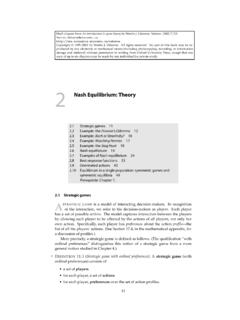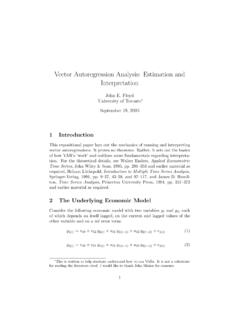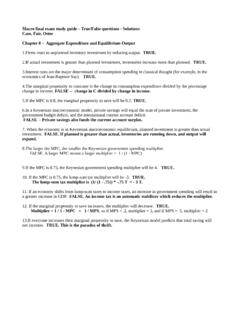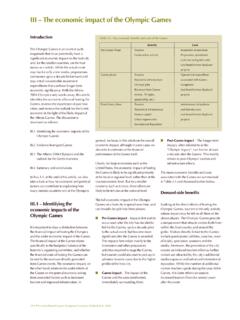Transcription of SOLUTIONS MACROECONOMIC THEORY Term Test #1
1 Page 1 of 10 Department of Economics Prof. Gustavo Indart University of Toronto June 8, 2012 ECO 209Y L0101 MACROECONOMIC THEORY Term Test #1 LAST NAME FIRST NAME STUDENT NUMBER INSTRUCTIONS: 1. The total time for this test is 1 hour and 50 minutes. 2. Aids allowed: a simple calculator. 3. Use pen instead of pencil.
2 DO NOT WRITE IN THIS SPACE Part I /40 Part II 1. /10 2. /10 3. /10 4. /10 TOTAL /80 SOLUTIONS Page 2 of 10 PART I (40 marks) Instructions: Enter your answer to each question in the table below. Only the answer recorded in the table will be marked. Table cells left blank will receive a zero mark for that question. Each question is worth marks. No deductions will be made for incorrect answers. 1 2 3 4 5 6 7 8 9 10111213 14 1516C D C C D A C A C E A C D D D C Use the following information to answer questions 1 and 2. Suppose that an economy produces only apples, bananas, and oranges, and that price (in dollars) and quantity (in pounds) data are given in the table below.
3 Year 2000 Year 2010 Good Quantity Price Quantity Price Apples 3,000 $2 4,000 $3 Bananas 6,000 $3 6,500 $2 Oranges 8,000 $4 9,000 $5 1. The percentage increase in nominal GDP between 2000 and 2010 is A) 15 percent.
4 B) 20 percent. C) 25 percent. D) 30 percent. E) none of the above. 2. Considering the year 2000 as the base year, the percentage increase in real GDP between 2000 and 2010 is approximately A) 7 percent. B) 9 percent. C) 11 percent. D) 13 percent. E) 15 percent. Use this space for rough work. Page 3 of 10 3. John buys a one-year government bond for $400. He receives principal and interest totalling $436 one year later. During the year the CPI rose from 150 to 162, but he had thought the CPI would be at 159 by the end of the year. John had expected the real interest rate to be _____, but it actually turned out to be _____. A) 8%, 1%. B) 6%, 3%. C) 3%, 1%. D) 1%, 3%. E) 3%, 2%. 4. Consider an economy without depreciation of the capital stock, without government transfer payments, and where personal income tax is the only source of government revenues.
5 If GDP is $980 billion, consumption is $650 billion, private savings is $120 billion, government purchases is $180 billion, and net exports is -$30 billion, which of the following is true in this economy? A) Disposable income is $860. B) Investment is $120. C) The budget deficit is -$30. D) Personal income tax is 250. E) None of the above. 5. The pop-corn industry produced $1 billion worth of pop-corn in 2011, using $500 million worth of corn as the only intermediate product. The pop-corn industry also paid $300 million in wages and salaries, $50 million in rent, and $50 million in taxes. The contribution of the pop-corn industry to the country s GDP in 2011 was A) $1,400 million. B) $1,000 million. C) $900 million. D) $500 million.
6 E) none of the above. Use this space for rough work. Page 4 of 10 6. Nominal GDP in 2000 was $1, billion, and in 2008 it was $2, billion. The GDP deflator is for 2000 and for 2008, where 2010 is the base year. Calculate the percent change in real GDP in the period from 2000 to 2008. Rounding off to the nearest percentage point, what was the percent change in real GDP in the period from 2000 to 2008? A) 32%. B) 104%. C) 132%. D) 169%. E) None of the above is correct. 7. The reason that an increase in autonomous spending leads to an even greater increase in equilibrium income is that A) the multiplier increases with an increase in autonomous spending. B) people save less as their income increases. C) as firms increase output to meet demand, income increases, and this induces more consumption spending.
7 D) there is unwanted inventory accumulation, leading firms to lower prices thereby encouraging increased consumer spending. E) the demand for money increases. 8. Acme Steel Co. produces 1,000 tons of steel. Steel sells for $30 per ton. Acme pays wages of $10,000. Acme buys $15,000 worth of coal, iron and other inputs needed to produce the steel. Acme pays $2,000 in taxes. Acme s contribution to GDP is A) $15,000. B) $20,000. C) $25,000. D) $45,000. E) none of the above. Use this space for rough work. Page 5 of 10 9. Suppose that the government has a balanced budget. It collects $30 billion in taxes, pays $10 billion in Social Security benefits, pays $2 billion in interest on the national debt, and pays government workers $18 billion in wages.
8 The government contribution to GDP is A) $0 billion. B) $12 billion. C) $18 billion. D) $30 billion. E) undetermined with the information provided. 10. Consider the fixed-price, aggregate expenditure model of the economy. Which one of the following will not be true when the marginal tax rate increases? A) The aggregate expenditure curve becomes flatter. B) Equilibrium output falls. C) Disposable income decreases. D) Consumption decreases. E) Savings increase. 11. Consider a closed economy with fixed prices and a balanced government budget at the initial equilibrium situation. A drop in government purchases will cause A) the level of consumption to fall, business inventories to rise, and a government surplus. B) business inventories to rise and a government deficit, but no change in the level of consumption.
9 C) business inventories and the level of consumption to fall, but no change in the government budget balance. D) both the level of consumption and business inventories to fall, and a government deficit. E) none of the above. 12. Consider a model of a closed economy where investment is independent of the level of income, the MPCYD is , and the tax rate (t) is A $50 billion increase in government purchases will lead to a change in the budget surplus of A) $50 billion. B) -$50 billion. C) -$ D) -$ E) +$ Use this space for rough work. Page 6 of 10 13. Assume a dealership in Toronto bought 40 Toyotas from Japan at a cost of $15,000 per car in July of 2011, and by December 31, 2011 have sold 20 of these Toyotas at a price of $20,000 each.
10 The remaining Toyotas were sold in January 2012 at a price of $18,000 each. The effect of these transactions on GDP in the year 2011 is A) $400,000. B) $300,000. C) $200,000. D) $100,000. E) none of the above. 14. Consider the aggregate expenditure model of an open economy where national income is $520, disposable income is $440, consumption is $410, net exports is negative at $11, and the budget deficit is $15. What is the level of investment? A) $106. B) $54. C) $30. D) $26. E) none of the above. 15. The ultimate objective of the austerians as Paul Krugman calls those obsessed with austerity programs is A) to eliminate government deficits. B) to reduce wasteful expenditures by the government .












